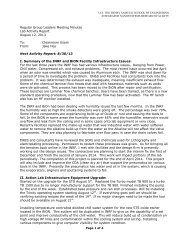Download Lab Safety Manual - Integrated Nanosystems Research ...
Download Lab Safety Manual - Integrated Nanosystems Research ...
Download Lab Safety Manual - Integrated Nanosystems Research ...
You also want an ePaper? Increase the reach of your titles
YUMPU automatically turns print PDFs into web optimized ePapers that Google loves.
Antimony, Arsenic, Barium, Beryllium, Boron, Cobalt, Gold, Manganese, Molybdenum, Selenium, Thallium,<br />
Vanadium, Cyanide, Formaldehyde, Phenols, any chemicals on the Federal List of Acutely Hazardous Chemical<br />
or the California List of Extremely Hazardous Chemicals.<br />
When in doubt about whether a chemical should be collected locally, check with the UCI staff. See the appendix<br />
for detailed procedures on local collection of chemical waste.<br />
5.5 Bringing New Chemicals or New Processes:<br />
By law, UCI is required to maintain an up-to-date list of the identities and amounts of all hazardous chemicals and<br />
materials in the entire lab. Violations jeopardize our ability to operate. In addition, with every new<br />
chemical/material brought into the lab, we need to ensure there is:<br />
• A safe way and place to store it<br />
• A safe way to use it<br />
• A safe method of disposing of it and its byproducts<br />
• A safe way to prevent cross-contamination of equipment groups<br />
All process chemicals and materials used in the lab must be approved by the lab staff and user group<br />
Committee before use. New chemicals and materials are approved for a given process, on a case-by-case basis;<br />
use of chemicals/materials for another process will require a new committee approval. To register a new<br />
chemical, material, or process, please be prepared with the following information:<br />
• Your name and full contact information<br />
• Your PI (advisor) or Company<br />
• The name of the new chemical (give all names commonly used)<br />
• If there are secondary new chemicals that must be used with this material (such as a developer for a new<br />
resist) list each of them here and supply MSDS’s for each of them.<br />
• Complete manufacturer/vendor information including contact information<br />
• A description of your plans for this new chemical/material/process (application notes and journal articles<br />
are very useful). You should have also checked to see if your chemical or something similar is already<br />
approved for use in the lab.<br />
Personal-use chemicals must be appropriately labeled (with identification of owner, contents, and other safety<br />
info, as per section 6.2). As this is an ever-changing research environment, there is a vast number of chemicals<br />
and material, and we need your help to keep track of them all.<br />
Because INRF/BiON is a community of researchers, we all need to be extremely considerate of potential<br />
problems posed by the hazards of new materials and how will they affect the research of others and, thus, the<br />
value of the lab as a research resource. The INRF and BiON staff should be able to answer most questions about<br />
which chemicals and materials can be brought in and where their use is acceptable in the labs. Please take time to<br />
carefully consider the process flow of your experiment and how it might affect other researchers and other<br />
downstream processes. Again if you have any concerns, contact the lab staff that will help you with your<br />
questions.<br />
6. Specific Hazardous Liquid Chemicals<br />
6.1 Solvents<br />
Flammable solvents<br />
Acetone, isopropanol, and methanol may be found at wet benches. Acetone is often used to dissolve photoresist<br />
and other polymer. Isopropanol and methanol are often used for cleaning.<br />
16



